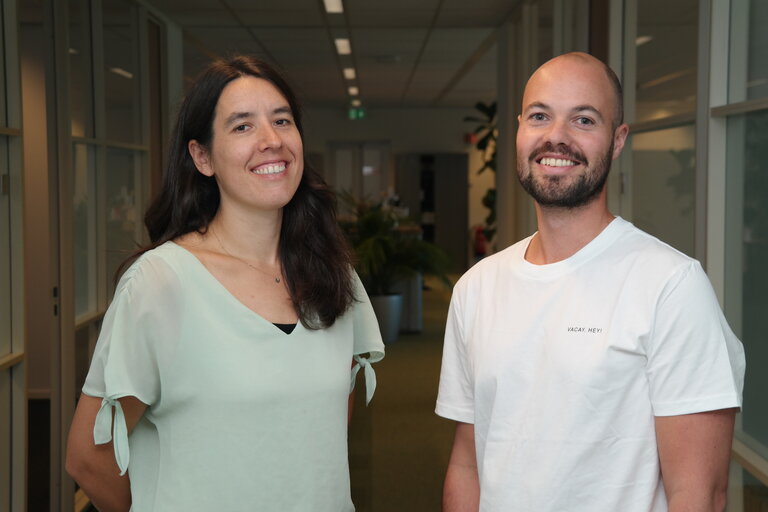
Six steps to a CO2 master plan
"What are we doing wisely? A common question when it comes to investing in the energy and resource transition. Industrial companies want to become more sustainable, but are wary of technology that has not yet been fully proven. Moreover, you don't want to bet on the wrong horse in terms of technology, because you are doing this for at least 20 years. Still, you want to get started, even if only with "low hanging fruit" such as energy efficiency and heat recovery. Bilfinger Tebodin has the solution and helps companies in six steps to their own CO2 master plan.
Manager Engineering Melanie Noorlander and Business Manager Industrial Sustainability Jordi Koes assist various customers in making a CO2 master plan. Jordi says: ‘Making a CO2 master plan takes some time and the customer has to gather a lot of data. But the reward is great: at the end of the ride, you have mapped out your improvement potential and you have a plan to get started on the projects that are best for you, including a schedule.’
Step 1: Data analysis
In this step, we take stock of the client's sustainability goal. How is the production process structured? What data are collected in which place? In addition, we make energy analyses and, if necessary, perform an energy scan. We also map out what raw material flows and waste flows exist.
Step 2: Zero measurement
Based on the information collected, we make a baseline measurement. In it we calculate the CO2 footprint and the environmental cost indicator, which also includes the shadow costs of your process and raw materials. Think of the environmental consequences of the extraction of your raw materials, or the transport emissions thereof, or your nitrogen deposition. It is a method based on LCA (Life Cycle Analysis) and is being used more and more.
Step 3: Environmental analysis
How many companies are in your area and what do they do? What streams could they supply or purchase? Jordi: ‘It happens surprisingly often that one company has a residual stream that the neighboring company could very well use. We also map out what infrastructure is nearby and whether there are plans for expansion. In Rotterdam, consider the hydrogen backbone, available grid capacity or a CO2 discharge line to the Porthos storage project. We also look at regional regulations and the plans that are in place in, for example, the Cluster Energy Strategy or Regional Energy Strategies (RES).'
Step 4: Mapping improvement potential
In this step, the engineers come into the picture. Melanie: ‘Often companies themselves already have ideas to make adjustments; and Bilfinger Tebodin's consultants and engineers also make suggestions. We collect all the ideas and assess what is realistic and what is not. We put the list of "approved measures" next to it. This is a system developed by the government to support companies in their obligation to save energy. Next year this list will be expanded to include mandatory CO2 savings. We elaborate on the feasible ideas and map out what it will take technically to implement it, and approximately what it will cost. Examples of many implemented projects are the reuse of waste heat, and electrification by replacing a gas-fired boiler with an e-boiler, for example.’
Step 5: Risks, opportunities and costs
Based on a longlist of possible projects we make in Step 4, in Step 5 we weigh opportunities and risks and can put a rough price tag on the projects. We also look at what subsidies are possible. Melanie: ‘In this step, engineering is needed. If you opt for a heat pump, for example, you do need to know exactly where it should be fitted into the production process and what capacity it should provide.' We also look at factors such as the grid capacity to electrify, the development of the price for CO2 emissions and the planning of major maintenance stops.
Step 6: Master plan
We create a road map that puts goals and projects into a schedule. With this, the company can get started!
Brake
Sufficient electricity is unfortunately currently a brake on many sustainability projects. There is simply not enough electricity available, let alone green electricity. Infrastructure for hydrogen and CO2 is also still lacking. Jordi: ‘I understand very well that our customers have doubts about what they are doing right. But that is precisely why this master plan is so useful. And there are promising developments: the pace of construction of wind farms is accelerating enormously, next year Gasunie will start on the hydrogen network and hopefully the knot will soon be tied around Porthos.
Mindshift
In recent years, Melanie sees a mindshift from have to want to when it comes to making the production process more sustainable. 'Before, companies did what they were legally obliged to do. Now there is an intrinsic motivation to become more sustainable. Of course, the pressure is also increasing from the EU, the Dutch government, the financial sector and their own employees. People want to work for a company that reduces its environmental impact. That, together with the great savings potential and the will to do the right thing for the climate, promotes the sustainability approach.'
Savings
You can create a CO2 master plan even for a factory that hasn't even been built yet. Melanie and Jordi proved that at the Japanese company Mitsubishi, which is building an MXDA plant in Rotterdam. Based on the roadmap, various CO2 reduction options and other sustainability measures were implemented in the design.
The result?
- A 10% reduction in CO2 emissions.
- -89% NOx
- -95% NH3
- -5% gas consumption
- -3% electricity consumption
